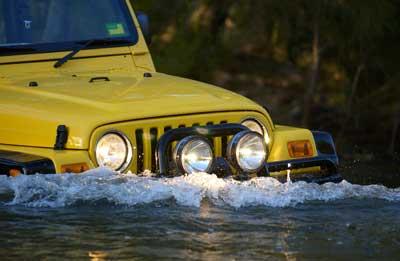|
Most people think that it’s winter which takes most toll on your 4WD’s battery, but the truth is quite the opposite.
Summer heat, coupled with a general lack of maintenance, is what beats your battery up most, so that when you increase its use in winter as the nights draw in and you probably use your headlights on at least one, if not both, journeys to and from work, you wake up one morning, get to your car, and it rewards you with that dreaded “whiir, hirrrrrr, wh, thunk” sound, followed by a click, then nothing.
That’s the last thing you need after waking up in a cold house, getting dressed while it’s still dark outside, and discovered the milk has gone sour and you can’t even have a cup of tea!
The battery is stone dead, your neighbour has already left for work so can’t give your battery a jump start. So you have to call out the AA, your local garage, or a tow truck, and you sit and wait until they arrive to get you going again.
But it IS all avoidable, with a 10-minute seasonal battery check along with a few maintenance tips.
How do you know when your battery is on the way out? Here are the telltale signs of a low or failing battery:
• Your headlights look dim at idle and then brighten when you rev the engine.
• The starter turns slowly, barely starting the vehicle. But you may have alternator wiring problems that prevent the battery from fully charging. If that’s the case, schedule a service appointment. Check your fan belt. If it’s loose, frayed, cracked or glazed, have it serviced or replaced.
A low battery can also be caused by:
• Frequent short trips.
• Too many accessories left on or added.
• Look for a purchase date chart on the battery (it may be handwritten). The battery case will also have a decal stating its expected life, such as 60 or 84 months. If it’s near the end of this expected service life, replace it.
About a year ago my wife called me to help her at her office as her car wouldn’t start – this was during summer – and when I got there the first thing I looked at was the battery level. It was below the level of the plates inside the battery, leaving the tops clear of the plates.
It was a low maintenance battery, and these are often the worst for causing problems because they only require the addition of water once or twice a year, depending on conditions, and as such are often over-looked. Which is what had happened here.
Maintaining a sufficient electrolyte level ensures the electrolyte is neither too high nor too low.
The preference is to top up with distilled or de-ionised water and never over fill. I didn’t have any handy, but the frost which builds up in your deep freeze is pretty pure, and once melted can be a good substitute.
Luckily this all happened at lunch time. Once we had topped up the battery we left the vehicle to sit for a while at the office, and when it was time for my wife to go home the battery had recharged itself sufficiently to start the engine. A year later it’s still going strong, although now my wife makes sure she checks it regularly – and has distilled water handy.
One of the most important things you need to check – often – is that your battery terminals and cable connections are clean and tight to enable proper current flow. Ensure terminals are cleaned regularly during every major service.
At the same time you must ensure the battery is not loose on its mounting as vibration can cause damage to battery plates. In fact merely using your vehicle off-road can also cause problems of excessive vibration.
However there are batteries which resist this vibration – made for either 4WD or marine use – and they prevent damage to the battery’s innards by using fibreglass envelopes over the battery plates and extra attachment points to hold the plates in place within the casing.
|
Quite often, especially if your 4WD is a second or third vehicle, it can sit unattended in the garage, or even outside, for quite long periods.
However if you want your battery to perform in peak condition, it’s essential you keep it charged.
Under-charged or under-used batteries will slowly go flat over time which will reduce the life of your battery. It's important to keep a battery fully charged to ensure maximum life. If you’re not using the vehicle, a proper trickle charger – a better quality one which doesn’t overcharge the battery – should be used to keep the charge topped up.
Many people believe if your vehicle’s battery is flat it’s sufficient just to go “for a good run” and it will be fully charged again.
The fact is that a battery that’s been run flat requires full recharging, and you’d have to go from Auckland to Taupo to do that in the car, simply because the car’s electrical system is designed to give a trickle charge back into the system, not a massive boost.
The best thing you can do if your battery has been flattened is to put it on a charger, at least overnight”. But avoid overcharging as this causes rapid deterioration and corrosion which shortens battery life.
A battery needing to be topped up continually with water is a sure sign that the car's electrical system requires careful checking. This may also affect a maintenance free battery.
It’s always essential that you keep batteries clean and dry, especially when they’re used in muddy conditions – and if they do get wet or dirty, clean ‘em off as soon as possible as dirt on a battery's surface can lead to discharge and corrosion.
Also avoid spilling oil or grease onto the top of the battery.
To remove dirt or moisture, wash with a solution of bicarbonate of soda and water and rinse afterwards with clean water. Ensure vent plugs are in place at all times.
Three other factors can lead to the death of your battery.
Firstly, under-sizing for the vehicle. This can be caused by inadequate charging capacity, usually an undersized alternator for the expected load, such as when a bigger engine has been installed or the engine has been modified to make it more powerful.
It can also be caused by adding more lights to the vehicle.
Next up, a slipping alternator belt. This will result in a slow loss of charge in the battery as it won’t be getting all the power it needs to stay fully charged.
Finally, a faulty voltage regulator. If the battery isn’t getting enough charge it will continually run flat, and eventually die. If it’s getting too much the battery will boil dry in use, wrecking it.
|



